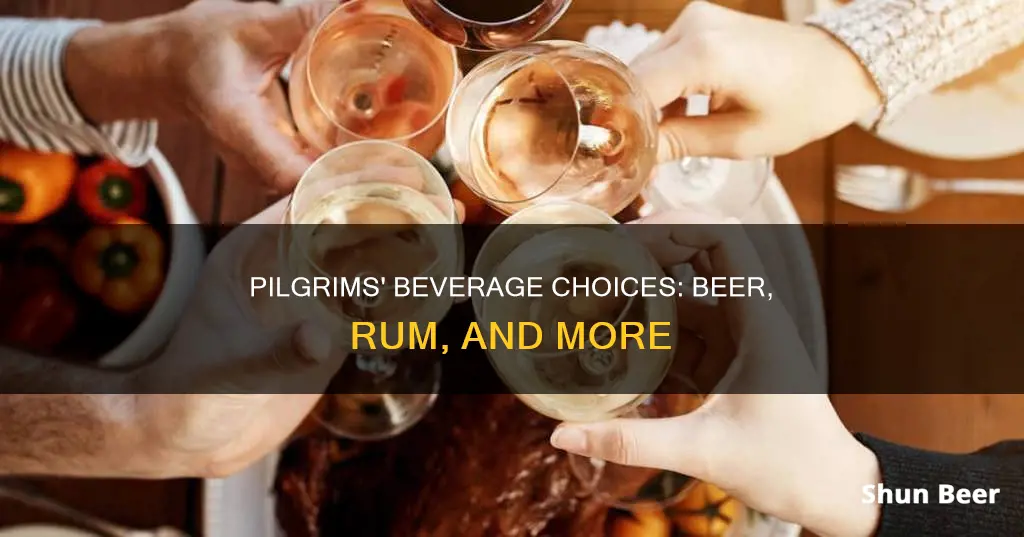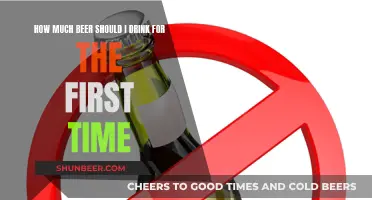
The Pilgrims have a dual reputation when it comes to alcohol consumption. On the one hand, they are sometimes portrayed as drunkards with a particular penchant for beer. On the other hand, they are depicted as stern and sober individuals who frowned upon excess. So, what's the truth?
Well, it's a bit of both. While the Pilgrims did drink beer, the notion of them being drunk on it, especially at the first Thanksgiving, is unlikely. Beer was commonly consumed in the Elizabethan period in Europe, and it continued to be a staple for the Pilgrims during their voyage to the New World. It was considered safer to drink than water, as the microorganisms that cause illnesses can't survive in alcoholic beverages. Each person aboard the Mayflower was rationed about a gallon of beer per day for the journey. However, due to various setbacks and delays, these rations became stressed, and they started running out of beer.
Upon landing, the Pilgrims remained suspicious of the local water, and it is unlikely that they had beer during the first Thanksgiving, as the ingredients were not readily available in the New England climate. While they may have had some beer left from their voyage, it probably wasn't enough to last until the harvest celebration. So, while beer was certainly a part of the Pilgrims' lives, the extent of their consumption may have been exaggerated over the years.
| Characteristics | Values |
|---|---|
| Beer consumption | Beer was considered safer to drink than water during long voyages at sea |
| Beer was rationed at about a gallon per day for each man, woman, and child aboard the Mayflower | |
| Beer shortage | The Pilgrims ran out of beer during their voyage, but this was not the main reason for landing in Massachusetts |
| The main reasons for landing were strong sea winds, the need to preserve dwindling stocks for the crew's return journey, and the onset of winter | |
| First Thanksgiving | The Pilgrims likely drank water at the first Thanksgiving, as any beer brought from England would have run out |
| The New England climate was not conducive to growing beer ingredients |
What You'll Learn

Beer was safer to drink than water
Beer was also safer to drink because water aboard ships was likely to become brackish and potentially deadly. Beer, on the other hand, remained drinkable. In addition, beer was commonly drunk in the Elizabethan period in Europe, and as a grain-based beverage, it was an important dietary staple. It was said to be "liquid bread".
The Pilgrims' preference for beer over water is well-documented. In his account of the Pilgrims, Plymouth Plantation governor William Bradford wrote that he and his companions "were hastened ashore and made to drink water, that the seamen might have the more beer." Bradford also noted that the Pilgrims remained suspicious of the local water once they reached land, as few of them were accustomed to drinking fresh water.
The Mayflower diary from 1620 also mentions the dwindling beer supply: "our victuals being much spent, especially our beer". This entry indicates that beer was considered a vital provision for the journey, and running out of it was a significant concern.
While there is some debate about whether the Pilgrims chose to land at Plymouth Rock due to a lack of beer, it is clear that beer played an important role in their journey and daily lives.
Beer and Azithromycin: Is It Safe to Drink?
You may want to see also

Beer was a dietary staple
The Pilgrims also drank beer because it was more sanitary than water, especially in urban areas. According to Peter Mancall, a history professor at the University of Southern California who studies the colonists, "they drank quite a bit—like other colonists, they drank beer".
Beer was commonly drunk in the Elizabethan period in Europe, but what they drank is different from the beer we're used to today. Beer and ale, being grain-based, were important dietary staples. For the common man (not nobility), in particular, grain made up a substantial part of the diet, with meat being fairly rare.
The Pilgrims also considered beer to be a luxury. In 1620, William Bradford, the settlers' leader, wrote in his diary that he and his companions "were hastened ashore and made to drink water, that the seamen might have the more beer".
The Pilgrims were also running low on other supplies, and the ship's crew wanted to return to Europe due to the brutal cold. However, beer was still an important factor in the decision to land.
Beer and Acid Reflux: Is There a Link?
You may want to see also

Beer was rationed on the Mayflower
The captain, Christopher Jones, was concerned about preserving the remaining beer for his sailors' return journey, which would be too dangerous to undertake until the following spring. So, the passengers were encouraged to land near the top of Cape Cod, where they could drink fresh water. William Bradford, the leader of the settlers, complained about this, noting that he and his companions "were hastened ashore and made to drink water, that the seamen might have the more beer."
The Pilgrims were suspicious of the local water, and Bradford attempted to negotiate with the captain for more beer, but he was rebuffed. The harsh weather conditions eventually drove the Pilgrims back aboard the ship, and on Christmas day, they were allowed some of the remaining beer. Despite this, half of the settlers died during that first winter.
The story of the Pilgrims running out of beer has become a part of American folklore, with some sources claiming that the Mayflower docked in Plymouth because they had run out of beer. However, this is largely considered a myth, as there was still beer on board for the crew's return voyage. The actual decision to land was likely influenced by a combination of factors, including low rations, brutal cold, and the desire of the crew to return to Europe.
Beer Drinking: Weight Loss or Gain?
You may want to see also

Beer was likely not present at the first Thanksgiving
The Pilgrims' journey to the New World in 1620 was long and arduous, and beer was an important part of their rations. Each person aboard the Mayflower was rationed about a gallon of beer per day, which was crucial for hydration and survival as the water aboard the ship had become contaminated and unsafe to drink.
However, the long journey meant that beer supplies were running low by the time they reached the New World. In fact, the shortage of beer may have contributed to the decision to drop anchor at Plymouth Rock, rather than their intended destination of Virginia.
Once they reached land, the Pilgrims would have needed time to establish crops and produce beer or other alcoholic beverages. The crops they needed for beer production, such as barley, would not have been established in time for the first Thanksgiving. As Kathy Rudder, an expert in the culinary history of the Pilgrims, notes, "The Pilgrims drank water... They drank it at the first Thanksgiving, they drank it every day."
While it is possible that there was hard apple cider at the first Thanksgiving, as there were native apple trees in the area, it is unlikely that beer was present. The notion of the Pilgrims drinking beer with their Native American counterparts at the first Thanksgiving is likely a myth perpetuated by the beer industry in advertising campaigns during the 1930s and 1940s.
So, while beer may have been a staple drink for the Pilgrims at other times, it probably did not make an appearance at the first Thanksgiving celebration due to supply and production constraints.
Drinking Beer While Driving in Pennsylvania: What's Allowed?
You may want to see also

Beer was used in advertising campaigns
Beer has been used in advertising campaigns for over a century, with some of the earliest examples dating back to the 1900s. In 1903, Miller High Life introduced the "Girl in the Moon" as its icon, a marketing phenomenon that swept the nation. The "Girl in the Moon" was said to be modelled after a daughter of the Miller family, and she continues to grace bottle necks to this day.
In the early 20th century, improvements in industrial processes and the advent of railways allowed breweries to expand their operations and distribute their products more widely. This, coupled with advancements in lithography that enabled the creation of bright, colourful prints in large batches, set the stage for the emergence of creative and impactful beer advertising campaigns.
One notable example of early beer advertising is the Pabst Blue Ribbon campaign. In 1882, Pabst started tying a blue ribbon around the neck of each bottle of its Best Select brew, positioning it as a high-end beverage. The blue ribbons became so iconic that they are still featured on Pabst beer can labels today.
Another pioneering beer advertiser was Guinness, which has been producing critically acclaimed advertisements since the 1700s. In the 1930s, art director John Gilroy began creating witty and entertaining print ads for Guinness that ran for nearly 30 years.
The late 1940s marked a significant shift in beer advertising with the emergence of television. Breweries began sponsoring sports telecasts and other TV programs, integrating their brands into popular culture. Hyde Park Brewery in St. Louis became the first brewery to sponsor a televised program in 1947, with other local breweries quickly following suit.
The early 1950s saw the introduction of catchy jingles and memorable characters in beer commercials. Carling Black Label Beer introduced the iconic "Hey Mabel – Black Label" campaign, featuring the charming bartendress Mabel, who graced television screens for nearly 20 years.
The 1970s brought a new approach to beer advertising, with Miller Brewing Company leading the way. Miller's "If you've got the time, we've got the beer" campaign focused on the consumer's need for a beer after a hard day's work, a theme that resonated with drinkers across the country.
As the impact of beer ads grew, companies invested more in their commercials, utilising celebrity endorsements, CGI effects, and creative storylines to capture the attention of viewers. Today, beer advertising remains a prominent feature of popular culture, with the Super Bowl serving as the ultimate showcase for the industry's creative endeavours.
Hand-Pulled Beer Pumps: Traditional, Unique, and Fun!
You may want to see also
Frequently asked questions
Beer was considered safer to drink than water in the 1700s, as many of the microorganisms that make people sick can't survive in alcoholic beverages. For this reason, beer was carried on ships like the Mayflower for long voyages. However, it is unlikely that the pilgrims were drinking beer at the first Thanksgiving.
The origin story is rooted in reality but was also helped along by the beer industry. Anheuser-Busch ran advertisements in 1908 touting beer as a drink of the pilgrims. In the 1930s, they adopted a campaign that claimed, "It Was Beer Not Turkey That Lured the Pilgrims to Plymouth Rock."
It is unclear what the pilgrims drank at the first Thanksgiving. While some sources claim they drank water, others suggest there may have been hard apple cider on the table.
The beer the pilgrims drank was different from the beer we are used to today. Beers were made out of many ingredients that we would consider odd today, such as cock ale, which was beer fermented or boiled with a rooster in it. Beers were also often strained through spruce, giving them a wood or pine quality.
There is no evidence that the pilgrims drank rum. However, they did drink other alcoholic beverages, such as cider and wine.







